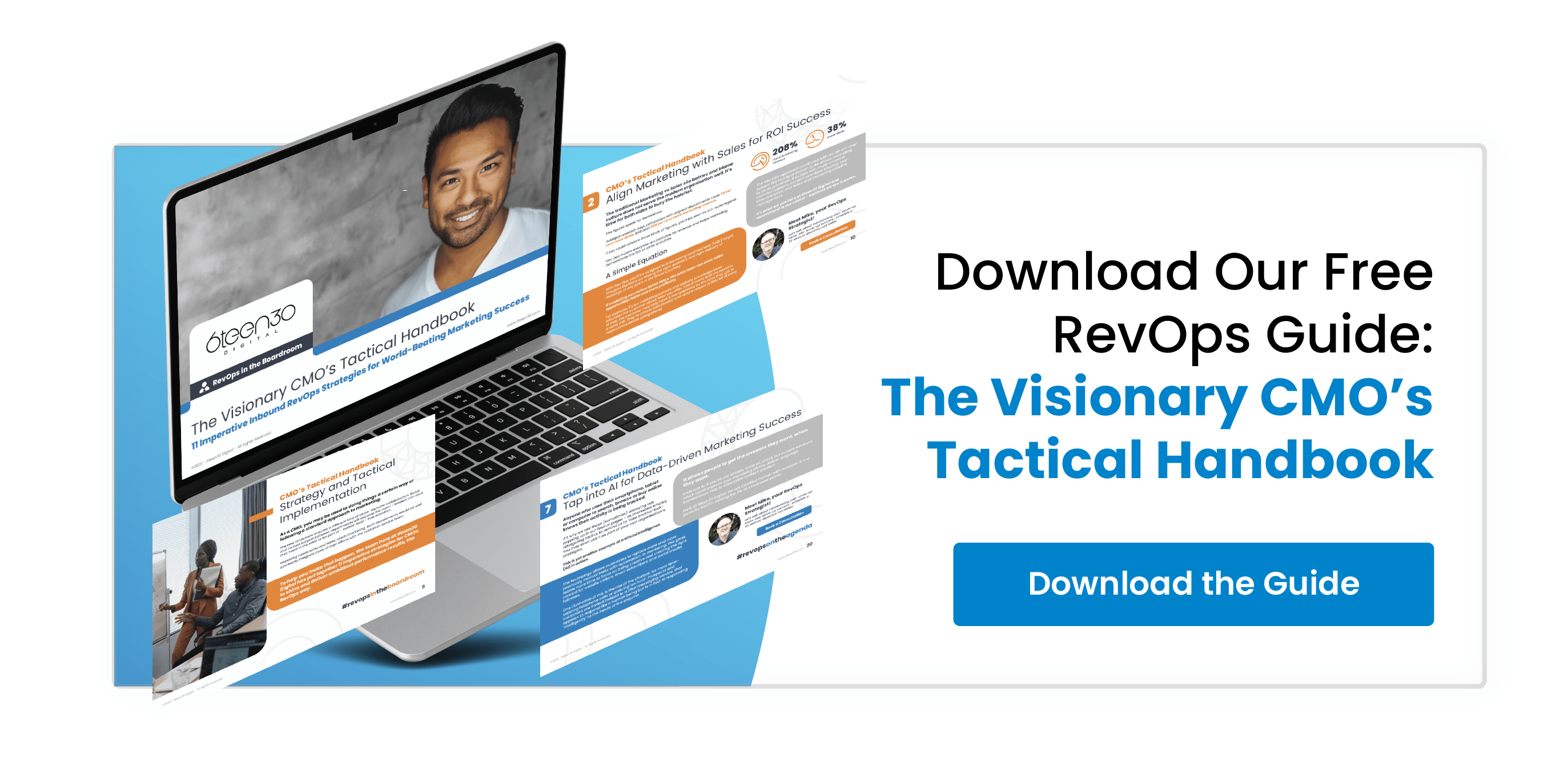
What Now, for Marketing? 11 Critical Challenges for Today’s Growth-Driven CMO
Who would want to be a marketing director or CMO today?
The responsibility to build the company brand, oversee increasingly complex multi-channel strategies, and deliver a rich stream of qualified leads to sales is pressure enough.
That on top of dealing with the demands of the marketing team, C-suite colleagues and customers - plus the uncertainties and budget restrictions created by recent global events.
The role may, at times, feel more like a poisoned chalice than a golden opportunity.
Today’s CMO requires vision to understand what lies ahead - and to change or adapt their approach to marketing, accordingly.
Here are 11 challenges to overcome for successful performance and growth.
1: Managing Market Uncertainty
The global pandemic has been a game changer for business.
Companies have been forced to adjust their operations: including what they sell, how they sell, what they do and how they deliver.
Whilst so many High Streets have suffered, the increase in online shopping has exploded. The upwards trend is likely to continue. According to Statista, ecommerce sales solely in the United States are expected to exceed $740 billion (around £535 billion pounds) a year by 2023.
The Challenge of Consumer Confidence
Uncertainty in the market has affected the majority of industry sectors. Whilst the GfK index detected a rise in consumer confidence in the UK in the early stages of 2021, levels are still well below those recorded the previous year.
That has created even bigger challenges for marketing teams, as they battle to win audience attention and attract new leads - typically with a reduced or restricted operating budget.
It’s a timely opportunity for CMO's to review strategies, resources and agency support.
Leaders with vision - who can see the bigger picture, and find new and innovative ways to respond - are likely to have an advantage in the drive for marketing performance growth.
2: Proving the ROI of Marketing Activities
Uncertainty in the market means companies will be looking even more closely at ways to deliver efficiency, savings and solid revenue to maintain profitability.
This could lead to tough conversations in boardrooms across the globe.
Whilst a World Economic Forum Survey reported 82 per cent of CEOs expected to see a recession (either U-shaped or double dip), the latest Annual CMO Spend Survey by Gartner revealed 73 per cent of marketing bosses expected the pandemic’s negative impacts to be short lived.
This level of optimism is at odds with the pessimism shared by CEOs and other C-suite colleagues.
Putting the Money Where Their Mouth Is
Despite that optimism, the Gartner survey also revealed 44 per cent of CMO's were facing mid-year budget cuts in 2020 - as a direct result of the pandemic. One in 10 were expecting cuts beyond 15 per cent.
Whatever their particular situation, CMO's are under increasing pressure to deliver and demonstrate the ROI of their team’s marketing activities.
Scrutiny is going to be on lead generation, the flow of qualified leads to the sales department, client acquisition costs and individual campaign performance.
Much of that boils down to having the right strategies in place. For the CMO, will that vision be conservative or a bit more imaginative?
It could spell the end for ancient “marketing vs sales” battles, and the dawn of a new spirit of inter-departmental cooperation and collaboration for the benefit of all.
3: Maintaining a Dynamic and Scalable Marketing Strategy
Strategy underpins a company’s marketing efforts.
The CMO must be part navigator, to sail through the current oceans of uncertainty, and part fortune teller, forecasting the likely picture ahead.
With so many unknowns and variables, there is likely to be a need to balance bold vision with calm pragmatism.
Innovation arrives with ever-increasing pace, which means shorter product cycles and potentially more markets to address.
Achieve More with Less
With money typically tighter, CMO's will be asked to do more with less. This will require a rethink of their marketing strategy.
Speeding up time-to-market involves being agile and responsive, optimising processes and having the right content ready for when the customer or prospect needs it.
Strategy needs to be flexible and capable of allowing the organisation to scale, profitably and sustainably. It must be sound yet also include some ‘give’ so it can adapt to real-world outcomes and impacts.
The visionary CMO will recognise this is only achievable by avoiding ‘silo thinking’. Marketing has to work more closely with C-suite colleagues to create a winning big picture.
Those who take the lead in fostering a whole-team approach are likely to gain favour with the CEO - and respect (however grudging) from their colleagues.
4: Creating a Winning Brand Experience for Customers
Activity on brand awareness may have taken a back seat for many marketing teams - as they focus on existing markets to fuel growth.
But that doesn’t mean companies can be complacent about brand reputation.
Customers expect things to be made smooth, quick and easy for them. That’s always been the case with B2C but it’s increasingly true within the B2B sector today.
Now wonder, according to a Deloitte study, that 88 per cent of companies are prioritising customer experience in their marketing strategies.
Removing the Friction
The customer experience doesn’t start the moment they buy a product or service. It starts from their first touch point and continues through the customer journey - and that is down to marketing.
It’s the website: home page. Lead magnets. Knowledge Base. FAQs. Chatbots.
It’s the activity: Social media posts. Facebook ads. LinkedIn articles. YouTube videos. Landing pages. Sales pages. Emails.
It’s the ethos: based on serving, informing and entertaining.
Strategies, tech and analytics available today allow a company to match their marketing to each stage of the buyer’s journey - Awareness, Consideration and Decision.
5: Delivering Personalisation
Matching marketing to each stage of the buyer’s journey involves tailoring the content along the way. It’s all part of the process of personalisation.
When content is tailored for someone, they are more likely to take notice of it. The more relevant it is, the more likely they are to engage with it.
It is said people now have shorter attention spans than goldfish. A Microsoft study measured the average span as just eight seconds.
Personalisation helps to overcome this communications challenge.
Getting Personal Improves ROI Performance
Global change management consultancy McKinsey believes “Personalisation can reduce acquisition costs by as much as 50 per cent, lift revenues by five to 15 per cent, and increase the efficiency of marketing spend by 10 to 30 per cent.”
Good reason for the forward-looking CMO to create the stage for personalisation to deliver that kind of performance.
It’s going to require the right team, up-to-date data, fresh and renewed marketing collateral, and a customer-centric approach.
Barriers to success with this way forward for a company, could be the quality of its digital technology and processes.
6: Accelerating Digital Transformation
Old-school marketing playbooks are largely redundant in the digital age.
The market in any sector can be disrupted by a new face. Amazon and Apple are now brand leaders, part of our everyday living and language. As are Netflix, Tesla, Uber and Airbnb.
Technology continues to improve and transform the way we all live. And COVID-19 has accelerated the rise in online shopping and browsing. It’s a trend that’s likely to hang around for some time yet - with little signs of any future reverse.
The Future is Digital
We have already seen how some companies who were slow to embrace the online shopping world have disappeared or suffered badly during the pandemic.
Even some of the biggest High Street brands have found the going tough.
Digital transformation is no longer a ‘nice to have’. It’s a ‘must have’. Companies who fail to embrace rapid change may find themselves slipping backwards from their rivals.
The buzzwords are going to be adaptability, flexibility, personalisation, integration and automation.
Today’s CMO's have to ask themselves some serious questions. What does digital mean for my business? What are the goals? How am I going to measure that? How can technology help achieve objectives? What do my team need to make the technology work?
7: Making AI Work for Marketing
The big disruptor brands share something else in common.
They are making obsessive use of artificial intelligence (AI) to better understand their customers and let technology automate routine tasks.
Many, many companies are following suit. It’s why you’ll notice chatbots and other interactive communications being used as part of a more personalised marketing strategy.
AI is here - and here to stay
Technology today allows any company to know more about people and what they are most likely to buy. You’ve probably experienced this yourself.
When you see a product recommendation it will usually be based on your online browsing history. When you have bought a product you may be shown other items with words like “If you like product X you’ll probably like product Y”. Amazon is king of this approach.
This machine learning is like playing a video game. Each time you play, you discover how to complete a stage and move up to the next level. You learn and apply the learning next time. That’s how it works with this tech.
It’s no longer a case of AI, are you in or out? For CMO's, it’s a matter of what level of investment are you prepared to put into it?
8: Getting the Martech Right
In addition to the strategic aspects of digital transformation, company conversation is also required around technology.
If an organisation uses “an old CRM for this, a tool for that and an app for another” then that’s quite a minestrone.
That tech ‘soup’ may provide data separately for marketing, sales and customer service teams but it makes sharing of that information clunky and time-consuming. It renders access to accurate, real time analytics for critical decision-making almost impossible.
And, of course, if a company is working with an external marketing agency or growth agency, the CMO needs to know how they are performing on any day of the week - not just at monthly or quarterly review.
Key Factors for Winning Martech
There is plenty of choice out there so the visionary CMO has to have a grasp of the solutions available, and to identify the right people and partners to resolve any tech-related challenges.
The technology should be:
-
Able to integrate with, or easily replace, the current tech
-
Powered by AI (so it can sort and analyse data and improve efficiency)
-
Easy to learn and manage
Having the right systems and tech in place allows companies to deliver a higher level of (cost-saving and time saving) marketing automation, as well as serve customers with a better experience along each stage of their buyer’s journey.
9: Data Privacy, Security and Cyber Risks
There are two sides to the data security coin for any business.
One is to protect their customers. The other is to protect the organisation.
Businesses (including their marketing bosses) must comply with often complex rules and regulations around data privacy and security. These may cover a world region, such as GDPR (General Data Protection Regulation) at a European level, or operate at a federal or state level, such as the California Consumer Privacy Act (CCPA) in California, USA.
Part of that work includes making it clear to customers the policies, procedures and standards in place to ensure the security of their data.
A Clear and Present Danger
The other side of the data security coin is about minimising the risk of cyber attack.
In the past decade, hackers have exposed data breaches and vulnerability to some big-name brands, including eBay, Equifax, Adobe, Boots, Canva, Marriott International, Virgin Media, Dubsmash and LinkedIn.
CMO's need an ongoing understanding of the regulatory climate and risk threats - to protect customers, to ensure their marketing department has everything in place and to feed into the overall C-suite strategy on security.
10: Having the Right People and Processes for Success and Sustainable Growth
CMO's may (according to one survey, at least) appear more optimistic about the future than their C-suite colleagues.
But those wanting more than ‘conservative’ growth will have to convince those colleagues that any investment is going to deliver a return, in the shorter term as well as in the years beyond.
Ambitious growth plans require the right strategy, upon which the company can lay the foundations to build the right processes, people and platforms to get the job done.
Whilst technology evolves at a rapid pace of change, organisations tend to introduce change at a slower, steadier rate. Bringing it all together is quite the challenge.
The New Marketing Mix
Marketing teams are likely to be using a hybrid model, a flexible mix of office and home working.
As genuinely customer-centric cultures become the norm, organisations will have to be more agile and willing to adapt.
The modern, vibrant and creative marketing team will no longer limit itself to people with a marketing background or degree. Those who are great at uncovering and analysing data, problem-solving and storytelling are going to be in strong demand.
The pressure is on CMO's to generate leads, minimise acquisition costs, expand personalised marketing, and work in a data-driven world. It requires the right processes and technology solutions - but also training for their teams in how to use the tech creatively, efficiently and collaboratively.
Advice or support from digital or growth agencies may be part of the equation as they tend to be familiar with, and often already use, these types of processes and solutions.
11: Keeping the C-Suite Happy
The boardroom can be a place of tension in times of uncertainty and stress.
It tends to exacerbate any issues already experienced because of silo mentality. Sales puts the blame on Marketing. Marketing fights back and says Sales are not doing their bit.
Each department focuses on making sure they are on track and performing to the right level - to make sure they look good during performance updates.
It’s Time to Ditch the Silo
Whilst that picture isn’t true of every organisation, the way to ambitious and sustainable growth will always be blocked and blunted by silo thinking. Collaboration throughout the business is critical - and it’s the smart or visionary CMO who chooses, and leads, that path.
That means aligning marketing with sales, and working more closely with customer service, too. It means sharing revenue targets, so each department’s success is connected with the success of others - for the greater good.
If marketing is performing well the CMO is going to be able to keep his or her CEO happy. If marketing is helping sales to deliver results, and vice versa, C-suite conversations with the sales director are going to improve.
The person who suggested this shift in thinking and way of working, as it delivers increasingly successful results, is going to seen as the hero of the story.
Revenue Operations - The Rising Star
Faced with these significant challenges, an increasing number of CMO's are exploring what’s possible with Revenue Operations, also known as Rev Ops or RO.
This approach aligns marketing, sales and customer service operations across the complete customer life cycle to drive growth.
Shared revenue targets mean all teams are accountable to revenue, not just sales. Shared data means teams can work together better for the greater good and the company better predict performance. Synchronised activity increases operational efficiency.
Rev Ops has been described as building the tracks and keeping the trains running on time.
The biggest challenges to implementation are typically company resources, inconsistent data and disconnected systems. It’s why organisations often reach for outside support to make it all happen.
Here at 6teen30 Digital, we use Revenue Operations to help clients align their marketing, sales and customer service teams. Our strategic GamePlan Workshop process combined with the HubSpot Growth Suite delivers a customised RevOps solution.
Statistics suggest the investment is worth exploring.
HubSpot research says companies with aligned departments close 38 per cent more deals and post 208 per cent more marketing revenue. A study by SiriusDecisions found public companies using Rev Ops saw 71 per cent higher stock performance.
If RO is delivering ROI in those kinds of numbers, it’s little wonder more and more CMO's and other C-suite leaders are exploring its possibilities.
To explore RevOps solutions from 6teen30 Digital, you can view our RevOps Journey path.
Turning Challenges into Opportunities
Today’s CMO faces a very different marketing landscape compared to the one of just a few years’ ago.
Pandemic-accelerated change has forced businesses to review, re-evaluate and - in some cases - reinvent themselves.
CMO's may have to focus less on brand building and more on fuelling the sales pipeline but that does not mean they can ignore the brand experience. Marketing is going to be more personalised, more highly targeted and more sophisticated than ever.
Those at the helm are going to have to embrace technological advances, lead the way on digital transformation, and ensure the right systems and process are in place - for successful, scalable growth.
All of that underpinned by smart, customer-centric strategy and a willingness to embrace a truly collaborative culture within the organisation, not just within the marketing team.
To discover more about how to use inbound strategies for successful Rev Ops growth, 6teen30 Digital has produced a free guide, called The Visionary CMO’s Tactical Handbook.








%20-%20Teal.png?width=500&height=130&name=Force%20%26%20Friction%20-%20Branding%20-%20Logo%20(White)%20-%20Teal.png)